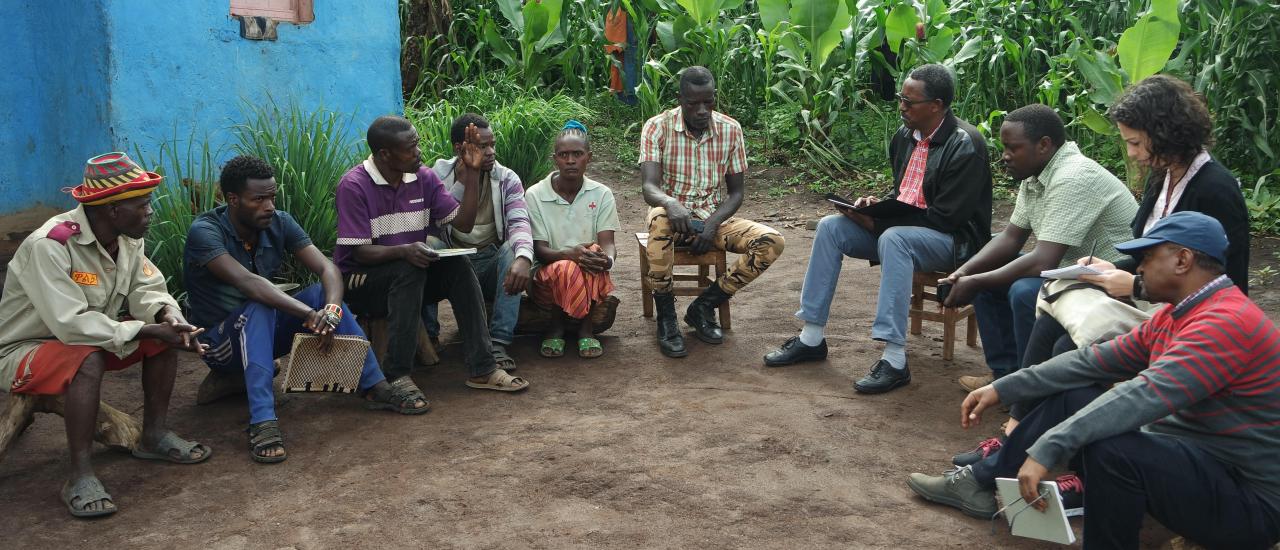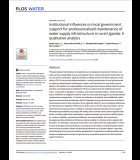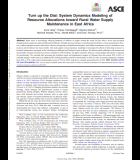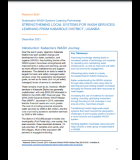A blog from Diana Harper, LINC
Last month, we held a discussion with the Sustainable WASH Systems (SWS) Advisory Board on the use of social network analysis (SNA) in international WASH programs. This presented an opportunity to reflect on the wide variety of SNA applications in the SWS Learning Partnership and what we have learned so far.
SNA is a systems analytic tool for exploring relationships. As part of an overall systems approach, SNA has been applied in the SWS Learning Partnership in Ethiopia, Kenya, Uganda, and Cambodia to:
- Design and plan WASH interventions: Understanding the current structure of the network informed SWS program strategies, interventions, and partnership approaches.
- Monitor WASH networks: Repeated SNAs offered insight into how network characteristics and behaviors shifted over time, particularly related to efforts to foster collective action.
- Develop WASH network solutions: SNA helped local stakeholders shift from a technical focus to a systems mindset that recognizes complexity, adaptation, and interactions.
To date, 12 of 19 planned applications of SNA have been completed, which has generated practical insights for WASH practitioners on how to best use SNA in low-resource settings.

You can read more about these SNA applications in this Learning Brief. When thinking about how to apply SNA successfully in WASH settings, I’d like to offer a few reflections based on the SWS experience and other SNA applications.
Lead with a systems perspective — not a systems tool. Sometimes, enthusiasm around a specific tool or analytic approach can lead the activity, rather than the activity leading the approach. Practitioners should identify the goals for their program and consider how a systems approach will help them to achieve their goals more effectively and sustainably. Then, when designing the analytic framework and implementation strategy for their program, practitioners can select the tools that best meet their needs and context. For example, in SWS, many activities are focused on increasing collaboration among a group of WASH stakeholders. As a result, in Ethiopia, Uganda, and Kenya, implementation teams selected SNA to help monitor change in relationship frequencies and structures as a result of collaboration interventions.
Right-size data collection. SNA is useful when the relationships and interaction among actors is important for how the local context functions and how the program is expected to achieve results. It is critical to align the research design with the expected use and to be very selective and deliberate about the design. It is easy to create SNAs that are larger than are needed for local analysis and decision-making, for example, by including too many relationship types. Both selecting and designing the right tools require time for planning, preparation, and adjustment, which need to be considered in the timing and budget for activities. Moreover, the absorptive capacity of the local team and stakeholders needs to be taken into account in this process. For example, in SWS programs in Ethiopia, during the design of the midline SNA, implementation teams reviewed how they had (or had not) used the data from the baseline SNA. During this process, they decided to eliminate some relationship types that were not adding value or answering questions necessary to their monitoring and implementation, such as who reported information to whom.
Engage stakeholders thoughtfully. It shouldn’t come as a surprise that SNA approaches that directly engage stakeholders and are integrated into the implementation are more likely to be applied and used. This process isn’t always easy, but there are good examples from SWS and in other WASH programs showing that transfer of the methodology can successfully occur. All of the SWS programs presented back the SNA findings to local stakeholders in a workshop format, both explaining what the tool is and jointly interpreting the results. Some teams also used participatory methods in data collection, helping actors to draw their own network maps. Overall, these participatory processes were well received by local stakeholders and seemed to prompt better discussion of network issues and solutions.
Use complementary tools and analyses. SWS activities are noteworthy for their application of complementary tools and analyses. Typically, SNA is not a standalone tool. It can describe the network as it is, but in order to properly interpret its meaning, other sources of information and contextual understanding are needed. Further, there is no one ideal network structure, so to make any conclusions about the strength or weakness of the network structure, and to make implementation decisions based on that, it is necessary to complement SNA with other activities. In SWS, SNA has been integrated with tools such as factor analysis, systems mapping, stakeholder understanding interviews, other key informant interviews, and building block analysis.
In the coming months, we will be developing additional learning materials for WASH donors and practitioners who seek to better use SNA in their work. If you have examples to share from your own work, or questions about this process, we hope to hear from you.






